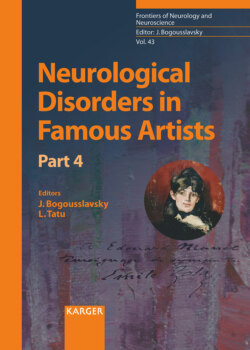Читать книгу Neurological Disorders in Famous Artists - Part 4 - Группа авторов - Страница 27
На сайте Литреса книга снята с продажи.
Abstract
ОглавлениеThe writer Louis Ferdinand Céline (1894–1961) developed a personal style which changed twentieth century French literature. As an enlisted soldier in 1912, he was involved in the Great War and his right arm was severely wounded. After the war, he became a medical doctor and a writer who published his first novel, Voyage au bout de la nuit (Journey to the End of the Night), in 1932. In the middle of the 1930s, he began to write anti-Semitic and racist pamphlets and turned to a collaborationist stance with Nazi Germany. After the Second World War, he was declared a national disgrace in France and fled to Denmark. In 1951, he was granted amnesty and went back to France, where he regained fame with his last three novels. Céline was a First World War neurologically wounded soldier who received a severe injury in the right arm leading to a radial nerve paralysis. Furthermore, in his texts and letters, he complained of many symptoms that he considered to be related to the First World War. In reality, to build a heroic image of himself, Céline rewrote his personal First World War history, in particular his war wounds. The aim of this reconstruction was to help him achieve literary fame. At the end of the Second World War, he also used this rewriting to organise his defence when he was accused and tried for collaborationism. Using medical and military archives, Céline’s First World War medical mythology is reviewed to distinguish facts from fiction concerning his wound and other war neurological disturbances. We present the history of his radial nerve lesion and surgery, and confirm that Céline was never trepanned. Two other controversial neurological points, his left ear disease and his possible shell shock, are also discussed.
© 2018 S. Karger AG, Basel
Louis-Ferdinand Destouches (1894–1961), whose pen-name was Louis Ferdinand Céline, is one of the most famous French-speaking writers of the twentieth century. He developed a personal style of writing that changed French literature.
Enlisted in a cavalry regiment in 1912, he was involved in the Great War and was wounded. After the war, he went back to school and eventually completed his medical studies in 1924. The subject of his medical thesis was Ignace Philipp Semmelweis and his war against infection in pregnancy wards.
His first novel, Voyage au bout de la nuit (Journey to the End of the Night), published in 1932, and other texts are deeply marked by the First World War. In the middle of the 1930s, Céline began to write anti-Semitic and racist texts, in particular three virulent pamphlets: Bagatelles pour un massacre (Trifles for a Massacre) (1937), L’École des cadavres (The School of Corpses) (1938), and Les Beaux draps (The Fine Mess) (1941). He turned to a collaborationist stance with Nazi Germany during the Second World War. In 1944, he fled to Denmark where he was imprisoned, and he was declared a national disgrace in France. In 1951, he was granted amnesty and went back to France. From his return to his death, he regained fame with his last three novels D’un château à l’autre (Castle to Castle), Nord (North), and Rigodon (Rigadoon).
Céline was a First World War neurologically wounded soldier. In October 1914, he sustained a severe injury in the right arm leading to a radial nerve paralysis. Furthermore, he complained of many symptoms that he considered to be consequences of war traumatisms. In reality, Céline progressively rewrote his personal history in the First World War, in particular his war wounds, to build a heroic image of himself. This reconstruction aimed to help him achieve literary fame, accompanying the publication of his first novel. He later used this rewriting to organise his defence after the Second World War, when he was accused and tried for collaborationism [Roynette, 2015].
Using medical and military archives, Céline’s First World War medical mythology can be reviewed to distinguish facts from fiction concerning his wound and war neurological disturbances. Here, we present the history of his radial nerve lesion and surgery. We confirm that Céline was never trepanned. We discuss two other controversial neurological points: his left ear disease and his possible shell shock.
